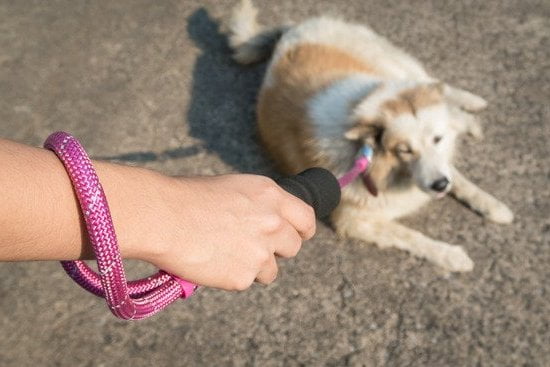Are you interested in learning about dog training clickers and how they can be an effective tool for teaching your furry companion? In this article, we will delve into the world of clicker training, exploring what a dog training clicker is and how it works. We will also discuss the evolution of dog training techniques and the science behind clicker training, providing insights into the benefits of using a dog training clicker and offering tips for effective clicker training.
For many years, dog trainers have been using various methods to teach dogs new behaviors and reinforce positive actions. With advancements in animal behavior research, positive reinforcement has become widely recognized as an effective approach to shaping a dog’s behavior. One tool that has gained popularity in positive reinforcement training is the dog training clicker.
Understanding the mechanism and effectiveness of a dog training clicker is essential for any pet owner or professional dog trainer looking to incorporate this method into their training routine. So, let’s explore what a dog training clicker is, how it works, and the advantages it offers for successful canine education.
The Evolution of Dog Training Techniques
One of the major breakthroughs in dog training came with the shift from punishment-based methods to reward-based ones. This change in approach was driven by a better understanding of animal behavior and psychology, leading to the development of positive reinforcement training techniques.
Clicker training is based on the principles of operant conditioning, a form of learning that relies on consequences to modify behavior. By using a clicker as a marker for desirable behavior followed by a reward, dogs can quickly learn new commands and behaviors.
Clicker training is not only effective but also humane and enjoyable for both dogs and their owners. The process promotes clear communication between the two parties, allowing for quicker learning and understanding.
As a result, clicker training has gained popularity among professional dog trainers as well as pet owners looking for an effective way to train their dogs. With its proven track record in creating well-behaved and happy dogs, clicker training is likely to continue evolving as new research further validates its effectiveness.
| Evolution of Dog Training Techniques | Benefits |
|---|---|
| Shift from punishment-based methods to reward-based ones | Effective and humane |
| Based on principles of operant conditioning | Promotes clear communication between dogs and owners |
Understanding the Science Behind Clicker Training
Clicker training is a positive reinforcement method that has gained popularity in the dog training world. This training technique is based on the principles of operant conditioning, a psychological theory developed by B.F. Skinner. Operant conditioning involves modifying behavior through the use of positive or negative reinforcement. In the case of clicker training, positive reinforcement is used to encourage desired behaviors in dogs.
The clicker acts as a bridge between the desired behavior and the reward that follows it. When a dog performs a specific behavior correctly, such as sitting on command, the trainer immediately clicks the clicker and then gives the dog a treat. The sound of the click marks the precise moment when the dog did something right, helping them understand which behaviors are being rewarded.
One of the key scientific principles behind clicker training is known as classical conditioning. When a dog hears the clicker, they begin to associate it with receiving a reward. Over time, this association strengthens, and just hearing the click becomes rewarding in itself for the dog. This creates a powerful incentive for them to repeat the behavior that earned them the click and subsequent treat.
| Advantages | Description |
|---|---|
| Precise Reinforcement | The click marks an exact moment when your dog does something right. |
| Clear Communication | It provides clear communication between you and your dog during training. |
| Positive Association | Dogs begin to associate hearing the click with receiving a reward. |
What Is a Dog Training Clicker?
A dog training clicker is a small handheld device that emits a distinct clicking sound when pressed. It is commonly used as a tool for positive reinforcement training in dogs. The clicker serves as a signal to mark the precise moment that a desired behavior is exhibited by the animal. This signal allows for clear and immediate communication between the trainer and the dog, making it an effective aid in dog training.
Understanding the Purpose of a Dog Training Clicker
The primary purpose of a dog training clicker is to serve as a marker for good behavior. When starting clicker training, the sound of the click should be paired with a reward, such as treats or verbal praise, to reinforce the positive behavior.
Over time, the dog will associate the clicking sound with receiving a reward, motivating them to repeat the behavior that elicited the click. This forms an association between the desired action and the positive outcome, making it more likely for the dog to perform that behavior in the future.
Utilizing Clickers in Animal Training
Clickers are not limited to just dog training; they are also used as effective tools in training various animals such as dolphins, horses, and birds. The principle of using a clicker remains consistent across different species – it provides clear communication and instant feedback between trainer and animal. The versatility and effectiveness of clickers make them popular among trainers who employ positive reinforcement techniques in animal training.
The Mechanism of a Dog Training Clicker
Sound and Reinforcement
A dog training clicker typically consists of a small plastic box with a metal strip inside. When you press the button, it creates a distinct clicking sound. This sound serves as a marker to pinpoint the exact moment your dog exhibits the desired behavior. The key to the clicker’s effectiveness lies in its ability to provide immediate feedback to your dog, indicating that they have done something right.
Classical Conditioning
The mechanism of the clicker operates on the principles of classical conditioning, which was famously demonstrated by Ivan Pavlov in his experiments with dogs. By associating the clicking sound with a reward, such as treats or praise, your dog begins to understand that the sound signifies something positive is coming their way. Over time, this association strengthens, making the clicker an invaluable tool for shaping your dog’s behavior.
Clear Communication
The beauty of the clicker’s mechanism lies in its ability to deliver clear and consistent communication. Unlike verbal cues or hand signals, which can sometimes be unclear or ambiguous, the clicker provides an unmistakable signal that indicates when your dog has executed the correct action. As a result, it helps create a strong and reliable line of communication between you and your canine companion during training sessions.
How Does a Dog Training Clicker Work?
A dog training clicker is a small handheld device that produces a clicking sound when pressed. This tool is commonly used in clicker training, a positive reinforcement method to train dogs. When used correctly, a dog training clicker can be a highly effective tool for teaching new behaviors and reinforcing good behavior in dogs.
The Mechanism of a Dog Training Clicker
A dog training clicker typically consists of a metal strip inside a plastic casing. When the button on the clicker is pressed, it causes the metal strip to bend and then snap back into place, creating a distinctive clicking sound. This sound serves as a marker to signal to the dog that they have done something correctly and will receive a reward.
How Does a Dog Training Clicker Work?
In clicker training, the click sound is immediately followed by giving the dog a treat or praise. The idea is to associate the clicking sound with the desired behavior and create positive reinforcement. Over time, the dog learns that when they hear the click, they have performed the correct action and will be rewarded. This creates clear communication between the trainer and the dog, making it easier for the dog to understand what is expected of them.
- Introduce your dog to the clicker by simply clicking and treating without any specific commands.
- Use the clicker during training sessions to mark desirable behaviors as they occur.
- Consistently follow up with praise or treats after each click to reinforce positive behavior.
Benefits of Using a Dog Training Clicker
Using a dog training clicker has several benefits that make it an effective tool in teaching and reinforcing desired behaviors in dogs. One of the main benefits of using a clicker is its precision in marking the exact moment when the desired behavior is exhibited. This clear and consistent communication helps the dog understand which specific action is being rewarded, making it easier for them to learn and understand what is expected of them.
Another advantage of using a dog training clicker is its ability to bridge the gap between the time when the behavior is exhibited and when the reward is given. Unlike verbal cues or commands, which can have variations in tone and timing, a clicker provides a consistent sound that signals to the dog that they have done something correctly. This immediate feedback helps in shaping and reinforcing behavior quickly and effectively.
Additionally, using a clicker in training can help strengthen the bond between the dog and their owner or trainer. The positive reinforcement provided by the clicker creates a sense of trust and cooperation between the dog and the person handling the training.
This not only enhances communication but also builds a positive association with training sessions, making them more enjoyable for both parties involved. Overall, the benefits of incorporating a dog training clicker into training routines are numerous, leading to more efficient and successful outcomes in shaping desired behaviors in dogs.
Tips for Effective Clicker Training
When using a dog training clicker, it’s important to ensure that you are using it effectively in order to achieve the best results with your pet. Here are some tips for effective clicker training:
1. Consistency is key: Be sure to use the clicker consistently and at the exact moment that your dog performs the desired behavior. This will help your pet understand which behavior is being rewarded.
2. Keep training sessions short: Dogs have short attention spans, so it’s important to keep training sessions brief and focused. Aim for 5-10 minute sessions several times a day rather than one long session.
3. Pair the click with a reward: In order for the clicker to be effective, it must be paired with a reward such as treats, praise, or toys. This will reinforce the positive behavior and encourage your dog to continue performing it.
4. Start with simple behaviors: When first introducing the clicker, start with simple behaviors that your dog already knows how to do. This will help them understand the association between the click and the reward.
5. Be patient and positive: Just like any form of training, clicker training requires patience and positivity. Avoid getting frustrated if your dog doesn’t immediately respond as desired, and always use positive reinforcement during training sessions.
By following these tips for effective clicker training, you can maximize the effectiveness of this method and build a strong bond with your furry friend through positive reinforcement.
Common Mistakes to Avoid in Clicker Training
While clicker training can be a highly effective method for teaching new behaviors to your dog, there are some common mistakes that pet owners should be aware of in order to ensure success. One of the most common mistakes is timing the click improperly.
It’s important to click at the exact moment that your dog exhibits the desired behavior, so they can make a clear association between the behavior and the sound of the click. If you click too early or too late, it can cause confusion for your dog.
Another mistake to avoid is using the clicker as a bribe rather than a reward. The clicker should not be used to lure your dog into performing a behavior, but rather as a signal that they have done something correctly and will receive a reward. Using the clicker as a bribe can lead to dependency on the sound of the click rather than understanding and responding to the desired behavior.
In addition, inconsistency in clicker training can also hinder progress. It’s important for all family members who are involved in training your dog to use consistent commands and timing for clicking in order to avoid confusion.
Consistency is key in reinforcing positive behaviors and ensuring that your dog understands what is expected of them. By avoiding these common mistakes, pet owners can maximize the effectiveness of clicker training and build a strong foundation for obedience and good behavior in their dogs.
Conclusion
In conclusion, the use of a dog training clicker is a powerful tool that harnesses the principles of positive reinforcement to effectively train our canine companions. As we have explored throughout this article, the evolution of dog training techniques has led to the emergence of clicker training as a gentle and efficient method for teaching dogs new behaviors and commands.
By understanding the science behind clicker training, dog owners can appreciate how this approach leverages operant conditioning to encourage desired actions in our pets.
The mechanism of a dog training clicker is simple yet ingenious, producing an audible sound that marks the exact moment when a dog exhibits the desired behavior. This clear signal allows for precise communication between trainer and pet, making it easier for dogs to understand which actions lead to rewards. As a result, clicker training has been shown to be highly effective in shaping positive behaviors in dogs, from basic obedience commands to more complex tricks and tasks.
The benefits of using a dog training clicker are numerous, including its versatility across different breeds and personalities, as well as its ability to build trust and strengthen the bond between dogs and their owners. However, it’s important for trainers to remember that consistency and patience are key to successful clicker training, along with avoiding common mistakes such as improper timing or over-reliance on treats.
By staying mindful of these factors and embracing the power of positive reinforcement in dog training, we can create happier, healthier relationships with our beloved pets.
Frequently Asked Questions
Does Clicker Training for Dogs Really Work?
Clicker training for dogs has been proven to be effective by many dog trainers and behaviorists. It is based on the principles of positive reinforcement, where the clicker is used as a signal to let the dog know when they have performed a desired behavior.
When followed consistently and correctly, clicker training can lead to faster and more reliable results compared to other training methods.
How Do You Use a Clicker for Dog Training?
Using a clicker for dog training involves pairing the sound of the click with a specific desired behavior, followed immediately by offering a reward such as treats or praise. The key is timing – the click must come right at the moment when the dog performs the behavior you want to reinforce.
Over time, the dog begins to associate the sound of the clicker with receiving a reward, making them more likely to repeat that behavior in order to hear the click again.
Do Dogs Learn Faster With Clickers?
Many trainers and dog owners have observed that dogs do tend to learn faster with the use of clickers compared to other training methods. The precise timing of the clicker helps dogs understand exactly which action led to the reward, leading to quicker associations between behavior and consequence.
Additionally, it can also lead to better communication between owner and pet, resulting in improved obedience and reduced frustration for both parties involved.

Welcome to the blog! I am a professional dog trainer and have been working with dogs for many years. In this blog, I will be discussing various topics related to dog training, including tips, tricks, and advice. I hope you find this information helpful and informative. Thanks for reading!





